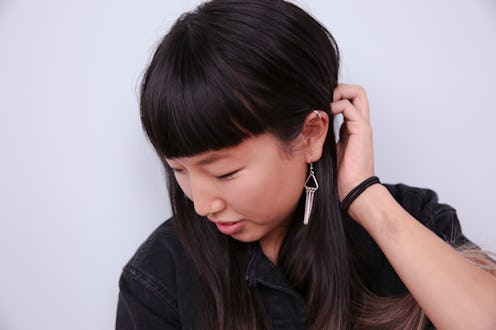Fashion
Here's A Handy Guide Of All The Different Ear Piercings You Can Get

Like any good '90s kid, I got my first piercing at Claire's. In between frosty pink lipgloss and leopard print snap bracelets, I committed to having a traditional earlobe piercing. Now that I'm all grown up (and a little bored) I've started wondering what are all the different cartilage piercing names? Here's the low down.
Cartilage piercings are arguably the easiest "next step" when it comes to body modification beyond ear lobes. There are tons of variations, so getting a cartilage piercing is a super personal decision that requires lots of research. Location, healing time, jewelry selection, and after care can vary by piercing and person, so there's a lot to consider when making the right decision for you.
When shopping around for a studio, is your professional going to use a piercing gun? While most people (like me) have good experiences with a gun, it can be more traumatic on your body than a needle. In some states, using a gun is illegal.
Your jewelry should be stainless steel or titanium, and approved by the Association of Professional Piercers (APP). Using the right jewelry will cut down on your healing time and body trauma, so do your research!
Here's all the different cartilage piercing names.
1. Helix
One of the most popular piercings of the moment is the helix piercing. A helix piercing is when cartilage on the outer upper ear is pierced. It can be so simple and delicate, and you can have as many as you can fit. Just know that it could take a little bit longer to heal, as it is in the outer area of the ear and there is less circulation there.
2. Anti-Helix Or Snug
A snug goes from the front side of the mid-helix through to the front side of the conch. It can swell to a greater degree than other piercings, so a longer piece helps in the healing process.
3. Flat
A flat piercing sits through the flat area of skin between your ear canal and cartilage. Flats are an adorably delicate edition to your jewelry game, but it can take a while to heal.
4. Conch
The inner conch is the cartilage at the center of the ear. Because of its cup shape, it makes it an ideal place for a small piece of jewelry. It can take up to four months to heal.
5. Tragus
The tragus is one of the most popular cartilage piercing options. It's the little flap of cartilage in front of your ear canal. Because it's on the inner part of your ear, it has a shorter healing time than a piercing on the outer ear.
6. Anti-Tragus
The anti-tragus piercing is one that goes through the fleshy hump of cartilage opposite of the conch. If you do get this piercing, consider getting a barbell or flat piece of jewelry to wear in it.
7. Daith
A daith piercing is a piercing that goes through the smallest fold of cartilage in your ear, right where the outer ridge that runs along the top of your ear connects to your inner ear. Apparently, this piercing can sometimes help those who frequently get migraine attacks, according to American Migraine Foundation.
8. Rook
A rook piercing is a cartilage piercing in the upper ear located above the tragus in the anti-helix. Typically, this piercing heals quickest with a curved barbell, and because they tend to stick out, it's best to not wear a circular piece until its entirely healed.
9. Industrial
An industrial piercing connects any two piercings with a single straight or curved barbell. Connecting a forward helix and mid-helix is the most traditional version of this option.
10. Orbital
An orbital piercing enters and exits the same part of the ear. It is made up of two different piercing holes, with one ring going through both the piercings.
This post was originally published on July 19, 2016. It was updated and republished on June 24, 2019. Additional reporting by Sara Tan.
This article was originally published on